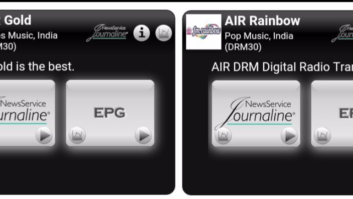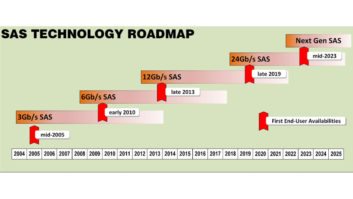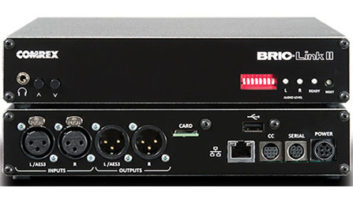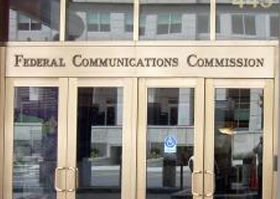David Layer, senior director, advanced engineering in the Technology Department of the National Association of Broadcasters, is the 2015 recipient of Radio World’s Excellence in Engineering Award.

David Layer speaks at the WorldDAB General Assembly 2015 and International Digital Radio Symposium in November.
Credit: Courtesy WorldDAB Recipients represent the highest ideals of the U.S. radio broadcast engineering profession and reflect those ideals through contributions to the industry. He is the 12th person so honored.
We recognize Layer for his work in radio technology advocacy and education, as well as in broadcast standards setting; for his enthusiastic support of numerous leading engineering organizations; and for his apparently inexhaustible energy. If it seems like David Layer is present anywhere and anytime that radio broadcast technology is discussed, it’s because, practically speaking, he is.
NAB ROLE
Layer, 57, has worked for the NAB for 20 years, having started as senior engineer. Today his office, mobile phone and email box together form a nexus of discussions and planning among the most influential technologists in the U.S. radio broadcast industry.
Considering how many facets of the industry he has touched, his project work alone qualifies him for Radio World’s award.
He is project manager for technology projects at NAB Labs, where he has directed numerous radio engineering undertakings including construction of its radio test bed facility. He’s been deeply engaged in NAB FASTROAD technology advocacy program projects such as FM IBOC asymmetric sideband transmission, an HD Radio Electronic Program Guide, IBOC SFN/digital booster development, improving power efficiency of transmission facilities and VHF/UHF antenna systems for integration in mobile devices.

Layer, left, troubleshoots a modem board at COMSAT circa 1994, with supervisor Mark Kappes looking on.
Credit: Courtesy David Layer He has hired and managed engineering experts for studies and tests involving such topics as Part 15 FM modulators, LPFM interference and elevated FM IBOC digital power.
Layer also is principal administrator of NAB’s Radio Technology Committee, a group of executives who advise the association on tech development and regulation; and he provides technical expertise to NAB’s government relations and legal people about broadcast regulatory and legislative matters.
SELF-EDUCATION
Growing up in the Washington suburbs, Layer remembers being fascinated by astronomy, math, journalism and photography. He edited his high school newspaper, took photos for the yearbook and served in his school’s AV department, videotaping basketball games.
He would visit the laboratory where his father worked as a research physicist for the National Bureau of Standards, now the National Institute of Standards and Technology, in Gaithersburg, Md. “I can remember being fascinated by the signal generators and oscilloscopes, and with his help would observe and play with Lissajous figures.”
At the University of Maryland he started as a radio/film major but soon switched over to tech. It fit him well; he became president of the university’s chapter of the national engineering honor society Tau Beta Pi and ultimately earned a bachelor of science in electrical engineering. Later he would add an MSEE from Purdue University.
In the mid-1980s, Layer parlayed a college co-op assignment at COMSAT Laboratories into an offer to join its technical staff.

Layer stands in front of a design drawing for a high-speed data modem that he developed at COMSAT. In his hand is the actual modem integrated circuit.
Credit: Photo by Bob Kovacs He spent a decade there, becoming associate manager in the Transmission and Channel Processing Department. A highlight of his technical and planning activities was designing an application-specific integrated circuit, a modem for satellite transmission of digital video, in 1993. He keeps a large plot of this chip on his wall.
But COMSAT, which had been created by Congress in the 1960s and at first enjoyed a monopoly position, was changing in the 1990s, going through a period of deregulation. It was a good time to move on, especially for a young man who sought to do more than spend each day in a lab. “I wanted to embrace the larger world.”
So when he spotted a want ad in the Washington Post for an association job involving both technology and journalism, he responded.
LIFE AT NAB
In one sentence, here’s a description of what David Layer does these days: “I go to a lot of meetings.”
He laughs when he says this, but it’s true, and it’s also OK. “I love working with people, and we accomplish a lot of important things.”
A better description, he says, would be, “I support NAB’s activities in the technical arena.” That means giving presentations, educating people, conducting research, writing, posting social media. He is active in NAB’s technical conference planning activities.
He professes to never being bored: “It’s one of the exciting things about working at a trade association.”
He loves that many of his colleagues — folks like John Marino, Janet Elliott and Kelly Williams — have been in the department for such a long time. He reports to Lynn Claudy, senior vice president of technology, but “we all work together.” More recent additions to the department include Skip Pizzi, Katy Armstrong, Tariq Islam, So Vang and the head of the department, Executive Vice President and Chief Technology Officer Sam Matheny.
Many radio industry people know Layer through his work on the association’s conferences and annual shows. “I’m really a lucky man to have landed this job that allows me to pursue all these things I enjoy: engineering, writing, working with people.”
It’s a good thing that he likes to travel though.
STANDARDS & MORE
On the standards side, he is the primary staff person for the National Radio Systems Committee as well as several of its subcommittees and working groups.

In familiar public address mode, Layer addresses a session at the Kansas Association of Broadcasters Convention in fall of 2015. We’ve written in Radio World often about NRSC and Layer’s involvement; you are likely well familiar with it. But his contributions to its standards are another important reason Radio World has named David Layer for our award.
NRSC is the technical standards setting body co-sponsored by NAB and the Consumer Technology Association (which until recently was called the Consumer Electronics Association).
His fingerprints can be found on NRSC-5-B “IBOC Digital Radio Broadcasting Standard,” NRSCG202 “FM IBOC Total Digital Sideband Power for Various Configurations” and NRSCG201-A “NRSC-5 Mask Compliance: Measurement Methods and Practice.”
He is present for virtually all NRSC events and conference calls, a boon to NRSC leaders past and present like Milford Smith, Charlie Morgan and the many engineers who head its committees. “The volunteers are the heart and blood of the NRSC,” Layer said modestly, “I just kind of corral them. It’s been an honor working with those folks.” But anyone who knows how the committee operates will tell you his work goes beyond corralling.
NRSC’s effort toward a digital radio standard in the United States was critical, probably its most influential project to date. More typical is the development of guidelines and best practices to help engineers get the most out of their station air chains. “It’s more mundane perhaps, but I’ve put my all into that.”
He was program manager for NRSC’s high-speed FM data subcarrier 67 kHz compatibility tests; and he is the NRSC’s liaison to the RDS Forum, a non-profit industry association based in Geneva that advocates for the FM RDS technology and keeps it current.
But wait, there’s more.

Nora Bosse and her husband David Layer are shown on a visit to the Brooklyn Bridge.
Credit: Courtesy David Layer Layer has served as NAB’s representative to the North American Broadcasters Association Technical Committee and is currently the association’s representative to NABA’s Radio Committee and chair of the latter’s FM chip working group. He was on the steering board of hybrid radio project RadioDNS; and his résumé includes technical work for NAB in the areas of next-gen television and satellite.
Like the good former high school newspaper editor that he is, he has been an author and contributor for NAB’s Radio and TV TechCheck newsletters and the McGraw-Hill Yearbook of Science and Technology. He contributed to the ninth edition of the respected NAB Engineering Handbook, was associate editor of the 10th and is reprising that role with the planned 11th edition. In 2001 he authored a notable cover story for IEEE Spectrum Magazine, “Digital Radio Takes to the Road,” prior to the adoption of digital radio in the United States and NRSC’s evaluation of the iBiquity FM HD Radio system.
The engineering community also knows him as a senior member of the IEEE and a leader of its Broadcast Technology Society, where he serves on the Administrative Committee, is a Distinguished Lecturer and has been the chair or co-chair of six annual IEEE Broadcast Symposia.
Need still more? He is an associate member and on the board of the Association of Federal Communications Consulting Engineers and past chair of its Scholarship Committee; and he’s a member of the Society of Broadcast Engineers.

All-digital AM field testing in 2013, late at night at Greater Media’s WBT. From left: Layer, Milford Smith and Jerry Dowd of Greater Media, Tim Hardy of Nautel, Dennis Wallace of Meintel, Sgrignoli & Wallace, Russ Mundschenk of iBiquity (now DTS), Gary Liebisch of Nautel and Dan Ryson of Cavell, Mertz & Associates.
Credit: Courtesy David Layer Others have recognized his work; just in the past year or so, he has received the Consumer Electronics Association’s Technology Leadership Award as well as the Matti S. Siukola Memorial Award for the Best Paper of the IEEE Broadcast Symposium.
And like every other responsible engineer, David Layer worries about where the next generation will come from.
“It’s not just gonna happen on its own. We can’t just expect the next generation to come walking through the door. We have to actively pursue it.” He applauds efforts by AFCCE, IEEE and the NAB Education Foundation’s Technology Apprenticeship Program, he said, but wishes the industry had more partners in the educational system.
So, like many of our past award recipients, Layer promotes technical education. You may have seen him speak at the Public Radio Engineering Conference in Las Vegas or at AES conventions. He has addressed broadcast association conferences in at least 14 states and Puerto Rico, speaking about digital radio, IPAWS, EAS and FCC technical rules. He has taught at American University, Frederick Community College and the U.S. Telecommunications Training Institute.
TIME MANAGEMENT
I ask wonderingly how he manages his time. Layer confesses that things can get stressful, but he points out that many of these activities are his own choice. And he’s inspired by people like Milford Smith, a fellow RW Excellence in Engineering Award recipient who has his hands full at Greater Media yet finds time for NRSC, the NAB Broadcast Engineering Conference and other efforts.

Layer shares a laugh with Kelly Williams, NAB senior director for engineering and technology policy. A photo on the wall shows Layer scuba diving, a favorite pastime.
Credit: Photo by Bob Kovacs Layer is supported in his pursuits by his wife Nora Bosse, who shares his love of travel. “She enjoys seeing me pursue engineering and broadcast with a passion.” Each has several grown children from previous marriages. The couple lives on a three-acre lot in a pastoral outlier of Washington/Baltimore.
When he needs to think about something other than technology, he’ll ride a bike, explore some home remodeling or — whenever possible — strap on the aqualung. Layer is a certified scuba dive master, an enthusiastic member of an informal broadcast industry club that also includes Smitty, Rick Ducey and Andy Laird among others.
At 57 he hopes to be gainfully employed at NAB for at least another decade.
“It’s a great place to work. Sam [Matheny] is taking us in a lot of new directions in what NAB Tech is doing.” And Layer is not the type to sit in a rocking chair on a front porch. “People who stay involved and active have better qualities of life.”
ABOUT RADIO
Beyond education and mentoring, how can today’s radio technologists advance our industry?
Layer mentions practical steps like making sure your facility is operating at peak performance and checking your digital time alignment. But he’d also like to see all broadcasters be more aware of creating a consistent user experience for radio, helping to roll out — “on every platform, on every station” — the kind of metadata and album art services that listeners have come to expect on other platforms.
“It’s not just up to the technologists obviously … but this is something we’re trying to get everyone to focus on. Consistent user experience is vital.” And that’s challenging for an industry of 15,000 or so individual broadcast stations licensed to thousands of owners who are not often on the same page about anything.
Among his proudest accomplishments is the all-digital AM field testing work he helped lead recently. It involved visits to nine AM stations, measuring the coverage of digital radio signals, gathering results and presenting them to the industry.

So what are his thoughts about the future of our medium? He’s excited about advances in digital radio, particularly the growing penetration of HD Radio receivers in automobiles. When he was in London at the recent WorldDAB assembly, he learned that three-quarters of new cars sold in the United Kingdom have DAB receivers.
“We’re approaching those numbers in the U.S.,” he said. “Digital radio on the FM side in particular is going well, and I think that will continue to be a good news story. Listeners are paying attention to multicast channels. … The stuff that NextRadio has accomplished is another great story.”
He expects the growth of radio in smartphones to accelerate, and is watching with interest to see how streaming audio for broadcast plays out.
He emphasized that he was speaking only for himself, but he said the goal for broadcasters should be to seek a viable presence on every platform.
David Layer is doing his part toward that. Still, he reminded me that he came from a background in digital and satellite communications, not radio or TV at all.
“These broadcast engineering executives and chief engineers and technicians are all so excited and passionate about broadcasting. I have to believe that not every industry is like this. … They’ve really accepted me and helped me along. There’s a lot I’ve needed help with; I’ve never wanted for help.
“I really feel blessed that I’ve become part of the community.”
Comment on this or any story. Email[email protected].









